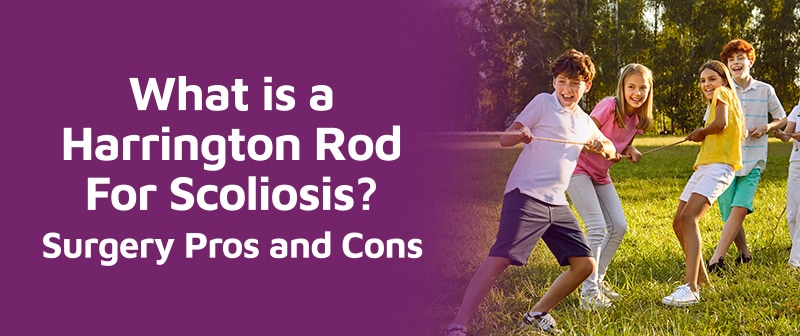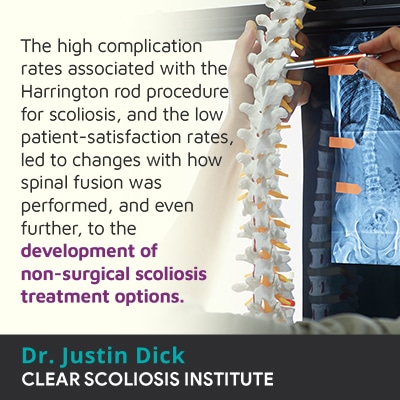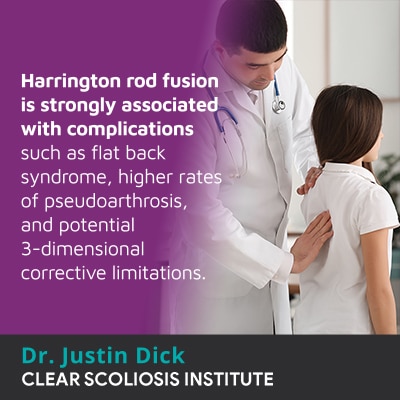
A Harrington rod for scoliosis is instrumentation used in spinal fusion; it's attached to the spine with the goal of holding it in a straighter position so its vertebrae can't become more tilted over time. Harrington rods implanted are permanent, and if one fails or malfunctions in some way, there is no reversing the procedure.
Surgical intervention for scoliosis has been in place for many years, and this has involved the use of a Harrington rod that's commonly attached to the spine with small hooks. Spinal fusion carries some serious potential risks that should be weighed carefully against the procedure's potential benefits.
There are two main treatment responses to scoliosis and knowing how each affects long-term spinal health is important.
Scoliosis is a common spinal condition that requires a proactive treatment response for the best potential results.
Traditional scoliosis treatment relies on surgical intervention to address the condition's progressive nature, but this doesn't address the condition's underlying structural nature.
Traditional scoliosis treatment doesn't focus on preventing progression, as much as it does on responding to it; on the path of traditional scoliosis treatment, if a patient's scoliosis progresses and becomes severe, they are often told that a surgical response is the best remaining recourse.
Modern conservative treatment, however, will respond to a scoliosis diagnosis very differently; it will start treatment immediately following a diagnosis because we now know that early intervention gives us the best chance of preventing progression and the need for invasive spinal fusion surgery in the future.
So the way a diagnosis of scoliosis is responded to will shape a patient's scoliosis journey.

The ratcheting system is used to stretch and tighten the spine prior to fusing it; spinal fusion often involves removing the intervertebral discs that sit between adjacent vertebrae to be fused, and as these discs are key to maintaining optimal spinal function, their removal shouldn't be taken lightly.
The intervertebral discs work together to make the spine stronger, more flexible, more capable of absorbing mechanical stress, and act as its shock absorbers; the discs also provide important cushioning between vertebral bodies, and this helps prevent degenerative changes within the vertebrae.
Once the discs are removed, the vertebrae can be fused into one solid bone. Because they are fused, there can no longer be movement, and this means the vertebral bodies can't become more tilted: progression. However, this exponentially increases the chance of accelerated degeneration.
Scoliosis progressing means a patient's Cobb angle measurement is increasing; this is a measurement that classifies scoliosis severity based on how misaligned the spine has become.
Harrington rod instrumentation that's attached to the spine is permanent, and once a spine is fused, there is no reversing it.
If a rod breaks or cracks, or a hook comes loose, the only recourse is more surgery, and that means facing the risks all over again, and of course the risks increase with each subsequent procedure and increased age.
The effects of spinal fusion will differ from patient to patient; there are many factors that shape how a patient responds to the procedure including patient age, condition type, severity, and the number of vertebrae fused.
The higher the number of vertebral bodies being fused together, the more complex the procedure is, and the more likely it is to cause adverse effects. The location of the fusion within the spine is also important.
There are three main portions of the spine. They include the cervical spine (neck), the thoracic spine (middle/upper back), and the lumbar spine (lower back). The spinal sections have to work together to maintain spinal health and function.
Although the spinal sections work together, they also have distinct functions based on their location; in most cases, the area of the body that's closest to the scoliotic section of the spine is going to mainly feel the condition's effects.
So if the spine is fused in the lumbar section, the lower back and body is likely to be the most affected, and a patient's spine being immovable in any section is not how it was designed. Many patients are disappointed when they realize their loss in spinal flexibility and range of motion is going to be permanent as this can greatly impact overall quality of life.

Flat back syndrome occurs if the spine has lost one or more of its healthy curve(s) and has become excessively straight as a result. This can cause a number of problems.
Flat back syndrome is a type of sagittal imbalance that occurs as the lumbar spine loses its natural lordosis (spinal curve that bends inwards, towards the body's center) and becomes excessively straight; the imbalance causes people to lean forward. This causes an uneven distribution of weight over the pelvis and legs.
The forward shift in posture causes changes to gait and can make it difficult for people to stand up straight and/or remain standing for extended periods of time, and when the body loses its natural state of balance and alignment, it attempts to counteract the uneven forces. This can lead to additional issues, such as: forward head posture, unnatural tilting of the pelvis, and flexing of the hips and knees.
It takes a lot more energy to remain upright and walk with an uneconomical gait because the body has to work extra hard to maintain balance. Over time, this can lead to lethargy, muscle pain, and pain.
To summarize, flatback syndrome is strongly linked with the Harrington rod procedure and common symptoms can include:
When the Harrington rod for scoliosis was a common treatment response, it often involved spinal fusions that extended into the lower lumbar spine. This corrective maneuver, when performed, commonly caused the lower back to lose its natural lordosis.
In many cases, patients could rely on the function of the spinal discs below the fused section to hyperextend, but over time, those discs degenerate, as the spinal discs are known to do. Then patients start to find it difficult to stand upright, experience back pain, other postural changes, and disruptions to long-term spinal health and function.
The high complication rates associated with the Harrington rod procedure for scoliosis, as well as, the low patient-satisfaction rates, led to the development of non-surgical scoliosis treatment options, as well as changes in how spinal fusion was performed.
Over the years, spinal fusion surgery has changed, including the methods and instrumentation used, and eventually, the Harrington rod for scoliosis was replaced by the use of bilateral pedicle screws; these were thought superior in their ability to provide three-column vertebral fixation and safely manipulate individual vertebral bodies.
As scoliosis is a 3-dimensional structural spinal condition, for any type of treatment to be effective, it has to address it as such. The use of pedicle screws addressed the lack of 3-dimensional correction associated with the Harrington rod procedure.
The main shortcomings associated with the use of the Harrington rod for scoliosis include implant failures, high rates of pseudarthrosis, flat back syndrome, and its limited potential for 3-dimensional correction. This has resulted in a high rate of revision surgery.
While treatment results can never be guaranteed, thanks to our evolving understanding of scoliosis and how it responds to different types of treatment, we have learned that many cases of scoliosis don't require surgical intervention, particularly with early detection and a proactive treatment response.
The main type of scoliosis is adolescent idiopathic scoliosis which involves young people. Preserving long-term spinal health and function should be a priority in this population. While spinal fusion can straighten a bent spine, despite its improvement over the years, a fusion method known to straighten the spine without any biomechanical disruptions has yet to be developed.
Modern conservative non-surgical scoliosis treatment is offered by the CLEAR Scoliosis Institute doctors, including Dr. Justin Dick of CLEAR Life Scoliosis Reduction and Chiropractic. Our patient success stories speak for themselves.

CLEAR provides a unique and innovative way of understanding scoliosis. Sign up to receive facts and information you won’t find anywhere else.
